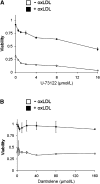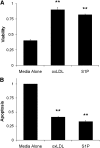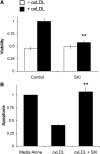Sphingosine kinase regulates oxidized low density lipoprotein-mediated calcium oscillations and macrophage survival
- PMID: 19965613
- PMCID: PMC2853467
- DOI: 10.1194/jlr.M000398
Sphingosine kinase regulates oxidized low density lipoprotein-mediated calcium oscillations and macrophage survival
Abstract
We recently reported that oxidized LDL (oxLDL) induces an oscillatory increase in intracellular calcium ([Ca(2+)](i)) levels in macrophages. Furthermore, we have shown that these [Ca(2+)](i) oscillations mediate oxLDL's ability to inhibit macrophage apoptosis in response to growth factor deprivation. However, the signal transduction pathways by which oxLDL induces [Ca(2+)](i) oscillations have not been elucidated. In this study, we show that these oscillations are mediated in part by intracellular mechanisms, as depleting extracellular Ca(2+) did not completely abolish the effect. Inhibiting sarco-endoplasmic reticulum ATPase (SERCA) completely blocked [Ca(2+)](i) oscillations, suggesting a role for Ca(2+) reuptake by the ER. The addition of oxLDL resulted in an almost immediate activation of sphingosine kinase (SK), which can increase sphingosine-1-phosphate (S1P) levels by phosphorylating sphingosine. Moreover, S1P was shown to be as effective as oxLDL in blocking macrophage apoptosis and producing [Ca(2+)](i) oscillations. This suggests that the mechanism in which oxLDL generates [Ca(2+)](i) oscillations may be 1) activation of SK, 2) SK-mediated increase in S1P levels, 3) S1P-mediated Ca(2+) release from intracellular stores, and 4) SERCA-mediated Ca(2+) reuptake back into the ER.
Figures









References
-
- Ross R. 1999. Atherosclerosis–an inflammatory disease. N. Engl. J. Med. 340: 115–126. - PubMed
-
- Libby P., Theroux P. 2005. Pathophysiology of coronary artery disease. Circulation. 111: 3481–3488. - PubMed
-
- Rosenfeld M. E., Ross R. 1990. Macrophage and smooth muscle cell proliferation in atherosclerotic lesions of WHHL and comparably hypercholesterolemic fat-fed rabbits. Arteriosclerosis. 10: 680–687. - PubMed
-
- Spagnoli L. G., Orlandi A., Santeusanio G. 1991. Foam cells of the rabbit atherosclerotic plaque arrested in metaphase by colchicine show a macrophage phenotype. Atherosclerosis. 88: 87–92. - PubMed
MeSH terms
Substances
LinkOut - more resources
Full Text Sources
Miscellaneous

